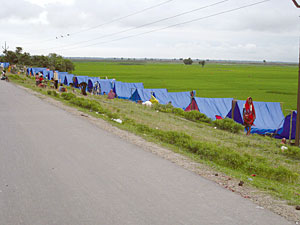 PRIYA JOSHI |
Rajendra Yadav is a small contractor in Kathmandu whose family is from Sripur. Yadav is not worried about the destroyed crops or his recently constructed concrete house being swept away. He is worried about his mother who is nowhere to be found. As his old neighbours fix a boat to go back to the village to look for her, a stoic Yadav says: "She may have gone over to Saptari or maybe she is in a camp. We will find her."
At a health camp in Inaruwa, run by the Maoist Kochila State Committee, women and children crowd around waiting for their chance. Sarita Devi, from Supaul in Bihar, waded through water with her child for a day to reach her relatives on the Nepal side. Her husband stayed back to take care of others. She found her sister but discovered there was no trace of her brother-in-law, who had gone to his native Haripur VDC for the rakhi festival right before the breach destroyed the village. "We don't know where our men are. Our children are unwell. But we at least have each other,"
she says.
The border has become meaningless because of family ties, logistical convenience and better relief operations in Nepal. At Jogbani station across the Biratnagar border, we met a man who works in Gujarat. After hearing about the floods, he rushed to Sunsari and took a boat from Laukhi to Bihar's Birpur because that was the only way to get there. He rescued his wife and two children, brought them back via Nepal and was waiting for a train to return to Surat.
As P Sainath said of droughts in India, everyone here seems to love a good flood. District administrators are thrilled with the relief money and hatch plans to skim it off. Boatmen are charging as much as Rs 12,000 at key points to take people back to their villages to find relatives or recover goods. Party activists have turned relief operations into patronage dispensation exercises. A new politician-contractor nexus is already taking shape for the repair work. Engineers at the road and irrigation departments are salivating over the money that will come in for reconstruction. The Bihari transport cartel knows if their highway does not give way, they can make a neat profit off Nepali passengers and goods.
The present disaster happened because of what water expert Dipak Gyawali calls the confluence of wrong technological choice, wrong institutional arrangements and Bihari-style politics. Indian policy makers preferred to live on in Nehruvian fantasies rather than heed warnings from their own activists. Bihari politicians and contractors looted state coffers annually. There was no co-ordination between the Kosi engineer in Birpur, the government in Patna, the MEA in Delhi and the embassy in Kathmandu when the crisis was brewing. And what can you expect from the illiterate Indian media which was busy accusing Nepal of "releasing water"?
On our side, a weak district administration did little to rein in local contractors blocking work. Some were MJF and Maoist supporters and their parties protected them. The authorities were criminally negligent by not acting on repeated warnings about an imminent breach.
The truth is little can be done immediately. N Sanyal, an octogenarian who headed the Ganga Flood Control Commission in the past, has been called back by the Bihar government to suggest measures. He told us: "Our action plan for now includes surveys, feasibility studies and procurement of material. We need to see how the river behaves. The actual closure will be an adventure." Other sources tell us work can begin only after March.
When asked about the weakness of the Kosi project, Sanyal remarked: "Our biggest weakness was overconfidence in the strength of the project. We were too complacent nothing would happen."



